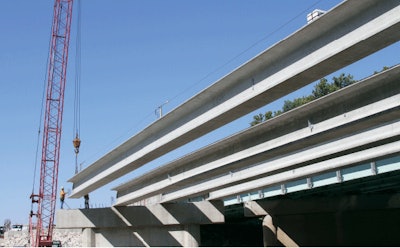The California Department of Transportation (Caltrans) is investing $3.2 billion to improve I-5 in Los Angeles County from Burbank to the Kern County line and from the Los Angeles/Orange County line to I-605. There are about 17 projects to complete these improvements:

The Santa Ana Freeway (I-5) South Corridor Improvement Project extends nearly seven miles from the Los Angeles County/Orange County line to I-605 to widen the freeway, bridges and overcrossings adding one High Occupancy Vehicle (HOV) lane and one general-purpose lane. In addition to the HOV connectors, there will also be new/realigned on- and off-ramps; new/realigned bridges; lanes specifically for trucks; additional general purpose lanes; upgraded frontage roads; new pavement; reconfigured interchanges; and grade separations. The entire project is slated for completion for the end of 2015.
A $1.6 billion package of six projects in the overall project will add nearly 14 miles of carpool lanes on I‐5 from the Los Angeles County/Orange County line to the San Gabriel River Freeway (Interstate 605). When completed, motorists will be able to travel seamlessly in a carpool lane from Downey to San Juan Capistrano, a distance of 44 miles.
This project requires extensive preplanning with a heavy emphasis on logistics. The temporary lane closures on the I-5 south corridor, the closures and detours of main freeway exits, the route the trucks hauling the girders must take along with CHP escorts, along with arriving on-site at the designated times for crane activities and completion of the activities within the allowable freeway closure times is also highly notable.
The project consists of multiple bridges. The San Antonio bridge is being constructed in three stages. Once the first stage is completed, all traffic will need to be converted over to the new bridge section. The second stage is comprised of demolishing a mid-section of the existing bridge then adding new girders and tying it back into the first stage. Then the third and final stage is started, which is converting traffic over to the second stage and then demolishing the remainder of the existing bridge. This is when the remainder of the new girders are installed and then opening the freeway up to all new traffic. This is all being accomplished while the freeway remains open and only partially reduced to traffic. The freeway is never completely closed to traffic.
For more information on this project, go to i-5info.com/i-5-south.
Oldcastle Precast Produces Longest Precast-Prestressed Bridge Girders for Caltrans
As part of the California Department of Transportation’s (Caltrans) $1.6 billion Santa Ana Freeway (I-5) South Corridor Improvement Projects, Perris, Calif.-based Oldcastle manufactured precast-prestressed concrete super girders to construct the Norwalk-San Antonio Bridge undercrossing section of the project.
The project’s general contractor, Sylmar-California-based Security Paving, contracted Oldcastle Precast- Perris to produce a 20, 158-foot-long, precast-prestressed concrete super girders. The super girders are wide flange beam design and were 8,500 psi in compressive strength.
The first stage, consisting of seven Oldcastle Precast super girders, were set in place in two nights, for the new Norwalk-San Antonio Bridge undercrossing in Norwalk, California.
This 158.5-foot long by 7-foot high bridge girder is the longest and the heaviest – which weighs in at 200,000 pounds – ever produced and set for a Caltrans project, according to the agency. Previously, according to Caltrans, the longest prestressed concrete girders were built on site at the State Route 2 Azusa Canyon Bridge in the San Gabriel Mountains in Los Angeles County.
The San Antonio Bridge undercrossing is being constructed in three stages, according to Oldcastle Precast – Perris. The first stage entailed seven girders; the second stage contained four girders; and the third stage contained nine girders.
The bridge is composed of prestressed girders, all of which are 158 feet long, supported by cast-in-place abutments that are transverse to the span and then a cast-in-place decking is placed atop the girders. The benefits of this type of bridge construction include: decreased construction time, improved safety for construction personnel and the public, improved structural performance and durability, and cost saving advantages.
For more photos, go to i-5info.com/photos.
Better Roads also took some time to talk with Oldcastle Precast about this project in this Q&A:
1. Why was Oldcastle brought onto the job?
Oldcastle has cast some of the largest/longest girders to date in California for Caltrans.
2. Did the contractor have any special quality requirements that the precast concrete girders helped to achieve?
Yes, This being a Caltrans project, as per the project special provisions, all precast girders are required to be manufactured only by a Caltrans pre-approved fabricator. All quality requirements must follow PCI standards and project specific Precast Concrete Quality Control Plan (PCQCP).
3. What was the overall amount of formwork used? Describe how it was used (i.e., forming sequence):
More than $250,000 of specially designed steel forms. Helser Industries manufactured the forms for Oldcastle.
4. What are the major challenges on this project?
• Ensuring the girder can be fabricated, transported and erected at the jobsite.
• The girder weight itself is 100 tons so a special lifting device is required.
• Fabrication: a) The required prestress force is 2,724, 400 pounds, and safety is the top concern. b) The required prestress force is exceeded our cast bed capacity. c) Due to girder narrow web, wider bottom bulb and heavy reinforcement in the girder, to ensure no honeycombing at the bottom bulb of girder is critical.) Review plant equipment to ensure they can produce and transport to storage area.
Putting Self-Consolidating Concrete vs. Traditional Mix to the Test
A new Missouri bridges is experimenting with these two types of concrete with hopes to save thousands for the state’s taxpayers.
Article and photos courtesy of County Materials Corporation
A new bridge spanning the St. Mary’s River on Highway 50 just east of Jefferson City, Mo., may not look unusual, but it could save the state’s taxpayers thousands of dollars in bridge construction costs throughout the next few decades. It is being used to test innovative concrete mixes side by side under real-world conditions in a series of research projects being conducted by the Missouri University of Science & Technology and Missouri Department of Transportation (MoDOT).
One test, in which Marathon, Wis.-based County Materials Corporation was involved, will assess the relative performance of girders constructed from two different mixes of self-consolidating concrete (SCC) – also known as self-compacting concrete (SCC) – alongside a traditional concrete mix. This will be the first bridge in Missouri to contain SCC.
SCC is a highly flowable, non-segregating concrete that spreads into place, fills formwork, and encapsulates even the most congested reinforcement, all without any mechanical vibration.
This is advantageous because SCC requires little to no use of mechanical vibrators to reduce entrapped air in the concrete during placement. It thus requires a smaller crew size, which leads to considerable savings in production costs. Also, when used to fabricate precast or prestressed concrete structures, SCC flows more readily between and around the steel substructure. A more elaborate steel framework is possible, which can reduce girder size and result in a stronger, more durable product. SCC mixes also contain less entrained air, so fewer bubbles and “bug holes” appear in the finished product to create a smoother, more aesthetically pleasing surface.
The flowability of SCC is measured in terms of spread when using a modified version of the slump test (ASTM C 143). The spread (slump flow) of SCC typically ranges from 18 to 32 inches depending on the requirements.
Most SCC mixes require an increase in the proportion of fines and a reduction of coarse aggregate compared to traditional concrete. This raises concerns that the materials’ shear resistance may be adversely affected, and that stiffness may be compromised. Researchers hope that the results of testing on this bridge will prove the materials’ merit and clear the way for the use of SCC on future transportation projects.
The three-span Highway 50 bridge contains three sets of girders fabricated by County Materials’ Bonne Terre, Mo., plant. The girders for the first span are made from a standard SCC mix. The second set of girders is manufactured with a high-strength SCC. This mix contains a higher percentage of cement for a stronger, more durable product with a compressive strength of up to 14 KSI. The third span is constructed with a standard Missouri DOT approved concrete mix design and functions as the control in the experiment.
Sensors embedded in the girders and bridge deck will allow researchers to monitor the materials’ performance over time, and provide real-world data about their relative strength as well as detailed information on the bridge’s internal stresses.
He says using the high-strength self-consolidating mix allowed the span length to increase by 20 percent, and is expected to reduce maintenance costs over the life of the structure. “Most of the current bridges (in Missouri) have a service life of 25-50 years,” Myers says. “We’re hoping to double that.”
For more information on this project, go to countymaterials.com/projects/bridge-girders-a-prestress/item/s-t-bridge-project-in-missouri?category_id=201.












